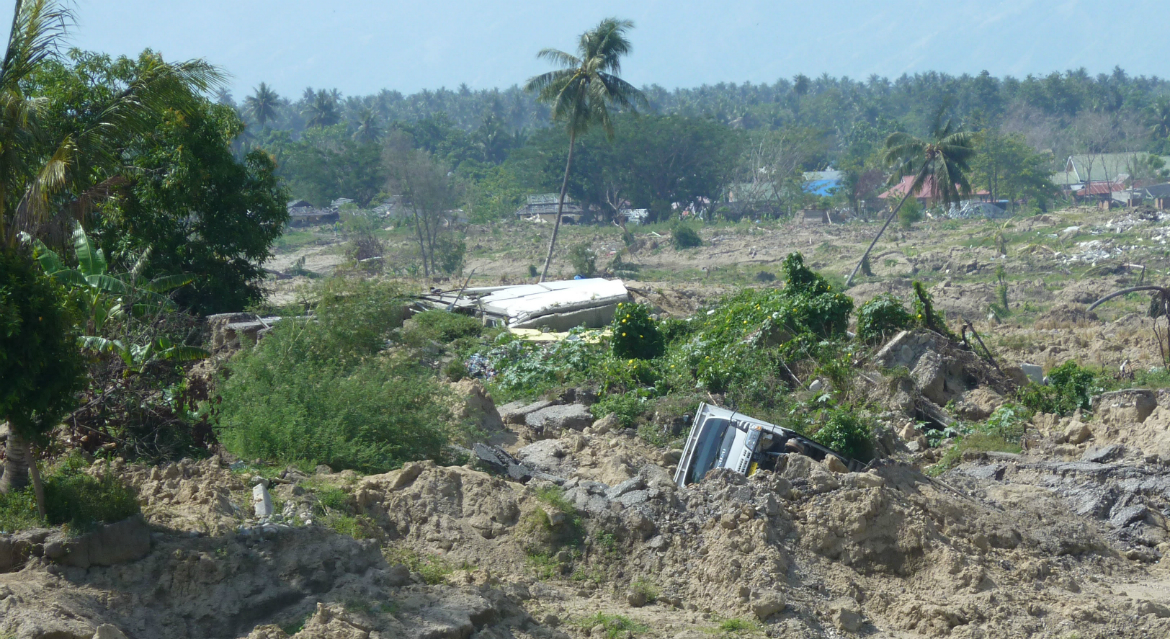“Liquefied” soil may have contributed to earthquake death toll
Published On Wed 12 Dec 2018 by Jonathan Watson

Soil conditions may have been responsible for hundreds of deaths following September’s deadly earthquake and tsunami in Indonesia, a University of Dundee academic has discovered.
Dr Andrew Brennan, from the University’s School of Science and Engineering, said high water levels in the ground in the province of Central Sulawesi may have allowed soil to liquefy, triggering several landslides that buried hundreds of homes in the disaster.
Dr Brennan recently returned from the affected city of Palu where he had been working in his capacity as an expert in soil liquefaction, which occurs when soil is shaken violently, pushing moisture to the surface and making ground unstable.
With more than 2,000 people declared dead and a further 10,000 injured following the event, Dr Brennan said that his examination of local conditions suggested that certain characteristics within the soil may have exacerbated the loss of life.
“The sheer scale of soil movement and the distance it can travel were beyond what I expected,” he said.
“All slopes in the world are being perpetually tested but several conditions mean that they tend to stay in place. Occasionally, however, there tends to be a combination of factors and tragedies like this occur.
“Some of the geological evidence suggests that there are steep slopes underneath the surface. The sand on top is made of several layers, but there are places in the city with steeper slopes and layers of different soil that can act as sliding surfaces, which appear to have contributed here.
“It would have been worse across the city if the soil had not been as dense. In some areas the soil particles were more tightly packed, which means it is less liquefiable. If that had not been the case then the destruction could have been significantly worse.”
The catastrophic loss of life occurred on September 28 when a magnitude 7.5 earthquake triggered a tsunami wave that struck the coast of the Minahasa Peninsula. As well as those killed and injured in the tragedy, more than 200,000 people are believed to have been displaced, with entire communities wiped out by the disaster.
Dr Brennan travelled to Southeast Asia as part of the Earthquake Engineering Field Investigation Team (EEFIT), which carries out technical evaluations of structures, civil engineering works and industrial projects in the aftermath of seismic events.
Spending seven days in Indonesia, he documented soil conditions near Palu, where liquefaction triggered mudslides that claimed hundreds of lives. His findings will be used to teach the next generation of engineers about liquefaction and assist those already working in seismic-reactive regions.
One of only a handful of academics to have visited the region since the tsunami, Dr Brennan acknowledged that he was taken aback by the scale of the disaster.
As the EEFIT team prepares to publicly present its findings in London next week, he said, “On our first day we were driving on roads where the tsunami had stripped buildings from either side of the road and that brought home the scale of the devastation to me.
“I was there to study landslides, which had accounted for more than half of the fatalities, and my role was to work out why these had happened and evaluate how safe similar areas might be now and in the future.
“At one point I was walking over the top of a landslide, which had buried a whole town, and seeing people’s personal effects just scattered on the ground was an extremely moving experience. But it also brought home the importance of the work we were doing in evaluating whether there are implications for similar sites worldwide, work which we hope may be able to save lives in the future.”
For media enquiries contact:
Jonathan Watson
Media Relations Officer
University of Dundee
Nethergate, Dundee, DD1 4HN
Tel: +44 (0)1382 381489
Email: j.s.watson@dundee.ac.uk